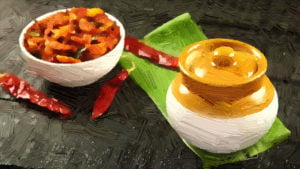Cucumber arrived in India circa 2030 BC from the Tigris (Iraq) valley, which created the euphoria of pickling products in brine. And 4,000 years down the line, pickled pleasures have taken the world of palates and taste buds by storm.
Pickle finds due mention in Ayurvedic texts as well as the Bible, praising its nutritive properties down the ages. Aristotle praised the curative powers of pickled cucumbers, and Napoleon fed his Army on them. Certain fruits like lemons and others rich in vitamins were preserved and fed to sailors to prevent scurvy and other ailments on long voyages.
Sweet, hot, spicy and tangy best describe this side-dish, of which there is an endless variety, encompassing almost every vegetable, fruit, meat and fish being used as a primary ingredient. Combinations have been tried out and several have emerged as all-time favourites. A combination of fresh seasonal ingredients mixed with spices, herbs, sweetening and souring agents are used as preservatives.

Pickle making in India is a national pastime, and is considered nearly every woman’s culinary achievement. Even in the hustle and bustle of cities, the lady of the house prides herself on serving “homemade” pickles whenever possible. The whole pickle-making process was once a family tradition with inputs from all members who helped in the chopping, cleaning and various stages of production. Right from carefully weighed spices being ground by travelling gypsies to the mixing by the khansama (cook) or housewife; the entire procedure was followed with plenty of discipline. The final result was that the pickle lived up to past claims of quality.
The term pickle encompasses a wide range of products including those that are vinegar preserved (like the Punjabi Gobhi Gajar Shalgam), those preserved in brine (like the Goan Water Pickle); sugar-based pickles (like Gujarati Chhunda or Murabba made all over the country) and those that are oil-based (classic Mango, Lime or Chilli pickle made in every household during the summer). Some pickles age like wine, and mature after a while and even keep for years; while others are made to be consumed fresh.
The use of certain spices like ginger, asafoetida, turmeric and fennel are used to help digestion; those like clove, cinnamon and ginger are used for their warming properties, while cumin and cardamom are cooling spices. The proportions of spices can overpower or downplay the outcome. No wonder then, that pickle recipes are the most fiercely guarded.
Consumed along with every type of cuisine, pickles are titillations of not just taste, but appetite too. Usually consumed with chapatis, rotis, bhakris and puris or as an accompaniment with rice or a main dish, pickles are sometimes also served with tea time snacks like matthris (crisp puris). This side dish forms such an integral part of our culture that one can rightly claim “There are as many pickles in India as there are dialects”. This simple technique of preserving seasonal ingredients in a lip-smacking combination of preservatives is not just limited to households anymore. Pickle making is today a huge industry in its own right.
Despite it being such an intrinsic part of our growing up, one wonders why recipes for the perfect pickle still go wrong sometimes. Using the best quality ingredients is the first principle to a good pickling process because spices can go only so far to cover up the flavours produced by ill-chosen ingredients. Also, since levels of sweetness or sourness vary, the amount of sweetening or souring agent used can also throw delicate flavours off balance. Another aspect is the preparation of spices. These are used raw, or roasted, whole or powdered.
Combinations are sometimes to a certain degree measured as pinches or handfuls as handed down by tradition, which makes it difficult for the modern day measuring tools of the spoon and cup wielding housewives. So the best way to learn is to begin by making small batches. This makes it easier to practice and also experiment with a variety of ingredients and methods. Common sense, regular practice, trial and error and accumulated experience will truly enrich anyone’s pickle making and relishing experience.


